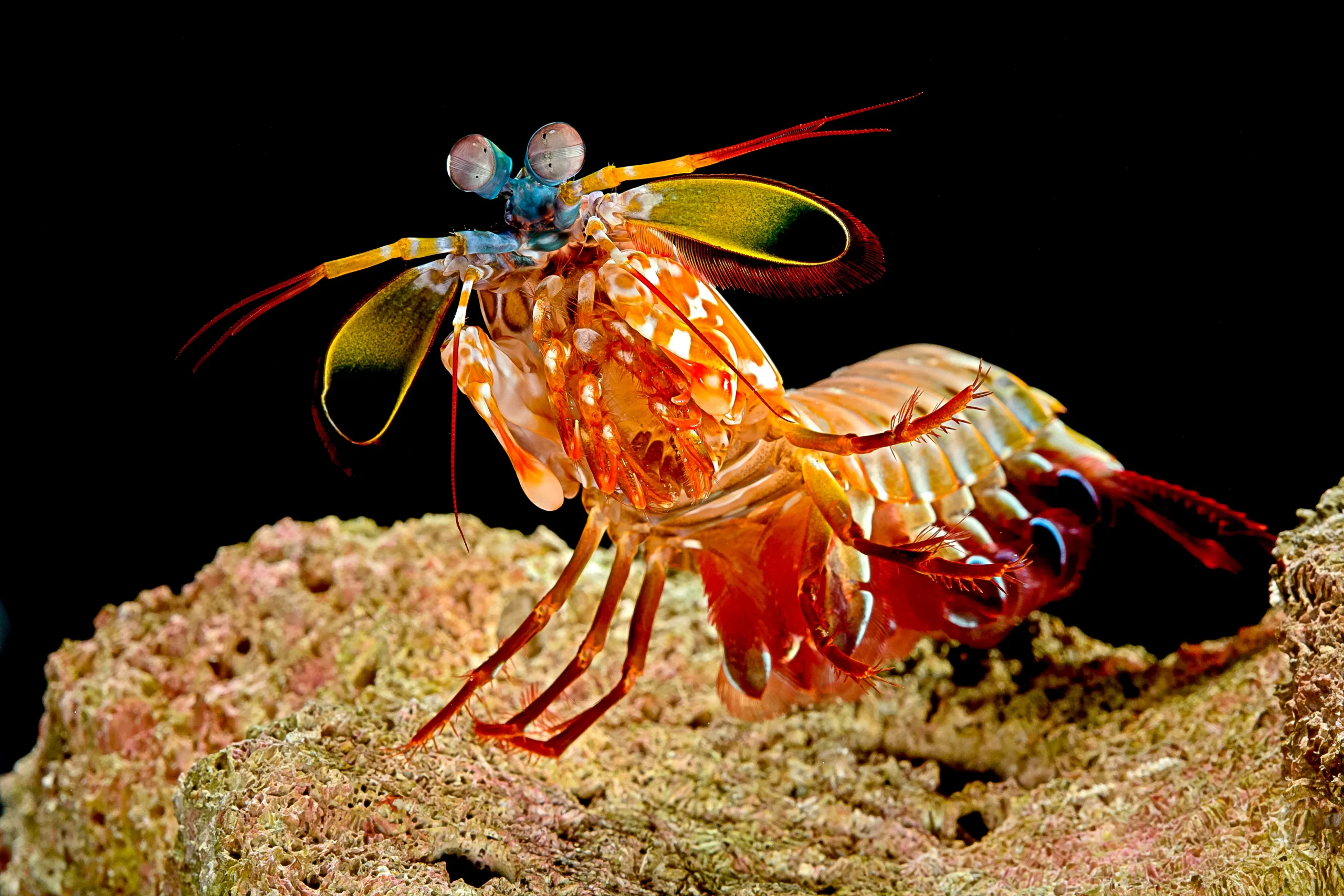
The mantis shrimp, a unique and fascinating crustacean of the Stomatopoda order, captivates with its remarkable characteristics and behaviors. From its lightning-fast strike speeds to its complex visual system, the mantis shrimp stands out as a marvel of the marine world. Let’s delve into the world of these extraordinary creatures and uncover the intriguing facts that make them truly exceptional.
The mantis shrimp, despite its name, is not a shrimp at all but a fascinating crustacean that belongs to the Stomatopoda order. These creatures are known for their unique characteristics and behaviors that set them apart from other marine species. With their distinct appearance and powerful appendages, mantis shrimps have captured the curiosity of scientists and nature enthusiasts alike.
Mantis shrimps are renowned for their incredible strike speeds, with some species capable of delivering blows at an astonishing rate of up to 23 meters per second. This remarkable speed allows them to catch prey with precision and efficiency, making them formidable hunters in the marine ecosystem. The sheer velocity of their strikes is a testament to the agility and strength of these remarkable creatures.
One of the most remarkable features of the mantis shrimp is its complex visual system, which surpasses that of many other animals. These crustaceans have eyes that can detect polarized light, giving them a unique perspective on their surroundings. The intricate design of their eyes allows mantis shrimps to perceive the world in ways that are beyond human comprehension, showcasing the wonders of evolution in the natural world.
Mantis shrimps possess two types of specialized appendages – raptorial claws used for hunting and smashing claws for breaking through hard shells. This dual-purpose weaponry equips them for a variety of tasks, from capturing prey to defending themselves against predators. The versatility of their claws highlights the adaptability and resourcefulness of mantis shrimps in their marine habitats.
Some species of mantis shrimps have been known to exhibit extraordinary strength, capable of breaking through aquarium glass with their powerful claws. This impressive feat demonstrates the sheer force that these crustaceans can exert, showcasing their remarkable physical abilities. The ability to break through solid glass underscores the strength and resilience of mantis shrimps in their underwater environments.
The mantis shrimp’s ability to see ultraviolet and polarized light sets them apart as visual marvels in the animal kingdom. By perceiving light beyond the human visible spectrum, these creatures have a unique advantage in detecting prey, communicating with each other, and navigating their surroundings. Their advanced visual capabilities shed light on the intricate adaptations that have evolved in mantis shrimps over millions of years.
With a history spanning over 400 million years, mantis shrimps are among the oldest species on Earth, showcasing their resilience and evolutionary success. This longevity in the evolutionary timeline highlights the adaptability and survival skills of mantis shrimps in diverse marine environments. Their ancient lineage offers valuable insights into the history of life on our planet and the remarkable adaptations that have allowed these creatures to thrive for millions of years.
The peacock mantis shrimp stands out as one of the most visually striking species, displaying vibrant hues of green, blue, and red on its exoskeleton. This colorful display serves both functional and aesthetic purposes, allowing the peacock mantis shrimp to blend into its surroundings and communicate with other members of its species. The vivid colors of this species showcase the beauty and diversity of marine life, captivating observers with their stunning appearance.
Mantis shrimps are renowned for their exceptional eyesight, boasting up to 16 different color receptors that far surpass human vision. This advanced visual system enables mantis shrimps to perceive a wide spectrum of colors and patterns in their environment, providing them with a unique perspective on the underwater world. The complexity of their eyes highlights the evolutionary adaptations that have fine-tuned mantis shrimps’ visual capabilities over millions of years.
The mantis shrimp’s punch is a remarkable feat of speed and power, capable of breaking through the tough shells of prey such as crabs and clams. The sheer force generated by their strikes, equivalent to speeds of a staggering 23 meters per second, allows mantis shrimps to incapacitate their prey with precision and efficiency. This extraordinary hunting technique showcases the predatory prowess of mantis shrimps and their ability to thrive as apex predators in their marine habitats.
Mantis shrimps employ a unique hunting strategy where they strike their prey with such force that water around the target actually boils due to the rapid movement. This boiling effect is a result of the extreme speed at which mantis shrimps deliver their strikes, creating a phenomenon that further enhances their hunting efficiency.
Mantis shrimps are distributed across tropical and subtropical waters globally, with over 400 identified species inhabiting diverse marine ecosystems. Their widespread presence in different regions underscores their adaptability to varying environmental conditions and highlights the importance of mantis shrimps in maintaining ecological balance in marine habitats.
Certain species of mantis shrimps exhibit complex social behaviors, forming monogamous pairs and engaging in intricate interactions with other individuals. These social dynamics among mantis shrimps provide insights into their communication methods, mating rituals, and cooperative behaviors within their communities.
The punch of a mantis shrimp is so forceful that it can create cavitation bubbles upon impact, leading to the production of light and heat as the bubbles collapse. This unique phenomenon showcases the extraordinary power behind a mantis shrimp’s strike and the fascinating effects it can produce in its underwater environment.
Mantis shrimps have garnered interest in materials science due to the strength and speed of their strikes, offering inspiration for innovative technologies. By studying the biomechanics of mantis shrimp strikes, researchers aim to develop materials and structures that mimic the efficiency and impact resistance seen in these remarkable crustaceans.
The eyes of mantis shrimps are mounted on stalks that can move independently, allowing them to scan their surroundings with exceptional precision. This unique eye structure grants mantis shrimps a wide field of vision and the ability to track movement effectively, enhancing their hunting capabilities and situational awareness in their marine habitats.
Some species of mantis shrimps utilize their powerful claws for burrowing into sand or mud, creating shelters for protection and reproduction. This behavior demonstrates the versatility of mantis shrimps’ appendages, which serve multiple functions beyond hunting and defense in their underwater homes.
The peacock mantis shrimp ranks among the largest species, growing up to an impressive length of 18 inches. This substantial size distinguishes the peacock mantis shrimp as a formidable presence in its marine environment, showcasing the diversity of sizes within the mantis shrimp family.
Mantis shrimps have been observed using their claws for communication, generating vibrations and sounds to signal to other individuals. This form of communication plays a crucial role in social interactions, mating rituals, and territorial displays among mantis shrimps, highlighting the importance of non-verbal cues in their underwater communities.
The force generated by a mantis shrimp’s punch is equivalent to that of a .22 caliber bullet, underscoring the immense power behind their strikes. This comparison emphasizes the incredible speed and impact force produced by mantis shrimps during hunting and defense, showcasing their prowess as formidable predators in the marine ecosystem.
Mantis shrimps are known to engage in complex courtship rituals, involving visual displays and claw waving to attract potential mates. These intricate behaviors play a crucial role in mate selection and reproductive success among mantis shrimps, showcasing the diversity of courtship strategies within the species.
The eyes of mantis shrimps are considered some of the most advanced in the animal kingdom, surpassing human eyes in certain aspects. Their exceptional visual acuity and sensitivity to light allow mantis shrimps to perceive their surroundings with unparalleled clarity, highlighting the evolution of specialized sensory adaptations in these remarkable crustaceans.
Certain species of mantis shrimps have been observed using tools, such as rocks, to break open the shells of prey. This tool usage demonstrates the cognitive abilities and problem-solving skills of mantis shrimps, showcasing their adaptive behavior in acquiring food and overcoming challenges in their marine environment.
Mantis shrimps exhibit a unique molting process where they shed their exoskeleton in pieces rather than all at once. This gradual molting strategy allows mantis shrimps to maintain protection and mobility during the molting process, ensuring their survival and well-being as they grow and develop in their underwater habitats.
The exceptional vision of mantis shrimps extends beyond the human visible spectrum, enabling them to perceive ultraviolet and infrared light. This expanded visual spectrum provides mantis shrimps with a broader range of sensory information, enhancing their ability to navigate, communicate, and hunt effectively in the diverse underwater world.
5 FAQs About Mantis Shrimp:
Why are mantis shrimp called “thumb splitters” and are they dangerous to humans?
Mantis shrimp have earned the nickname “thumb splitters” due to their incredibly powerful punches. Here’s a breakdown:
Supersonic Punch: Mantis shrimp can strike their prey with incredible force and speed, exceeding 100 mph (160 km/h). This rapid movement creates cavitation bubbles in the water, which collapse with immense pressure upon impact.
Penetrating Spears: Their raptorial appendages (modified claws) are tipped with sharp dactyls, capable of spearing or crushing prey with the force of a .22 caliber bullet.
Threat to Humans (Unlikely): Despite their impressive power, mantis shrimp are generally not dangerous to humans. Their strikes are primarily focused on catching prey or defending themselves within their burrows.
Respectful Observation: While not inherently aggressive towards humans, it’s important to observe them from a safe distance in aquariums or their natural habitat to avoid accidental encounters.
Fascinating Fighters: Mantis shrimp possess a remarkable predatory adaptation, although their power is primarily used for catching prey and not harming humans.
What are the different types of mantis shrimp and what makes them unique?
Mantis shrimp come in a stunning variety, each with unique adaptations:
Smashers vs. Spearers: Two main types exist: smashers with powerful punches for crushing prey and spearers with barbed appendages for impaling their targets.
Color Spectrum Punch: Some mantis shrimp possess exceptional eyesight with the ability to perceive a wider range of the color spectrum than humans, including ultraviolet light.
Blinding Speed: Their rapid strikes are so fast they can cavitate the water, creating a brief flash of light that may temporarily stun their prey.
Club Diversity: The clubs of mantis shrimp vary in size, shape, and even color depending on the species and its specific hunting strategy.
Underwater Wonders: The diverse mantis shrimp family showcases a remarkable range of adaptations and visual beauty.
What do mantis shrimp eat and how do they hunt?
Mantis shrimp are ferocious predators with specialized hunting techniques:
Ambush Hunters: They typically lie in wait within burrows, using their keen eyesight to detect passing prey.
Lightning-Fast Strike: Once prey is within range, mantis shrimp unleash their powerful punch, stunning or killing their target with a single blow.
Diverse Diet: Their diet varies by species, but they commonly prey on crabs, snails, worms, and small fish.
Club Customization: The structure of their clubs reflects their preferred prey; smashers have blunt clubs for crushing hard shells, while spearers have pointed ones for piercing softer bodies.
Predatory Prowess: Mantis shrimp demonstrate remarkable hunting efficiency with their powerful strikes and diverse club adaptations.
How intelligent are mantis shrimp and do they have any interesting behaviors?
Mantis shrimp exhibit surprising intelligence and complex behaviors:
Complex Social Lives: Some mantis shrimp species are social creatures, living in mated pairs and even exhibiting rudimentary communication skills.
Problem-Solving Abilities: They can navigate mazes, solve puzzles to access food, and even remember solutions for extended periods.
Visionary Prowess: Their exceptional eyesight allows them to perceive complex visual information and rapidly identify potential prey or threats.
Shrimpy Showmanship: Certain species engage in ritualistic displays and colorful fights, possibly for dominance or mating purposes.
Beyond the Punch: Mantis shrimp intelligence goes beyond their impressive strikes, showcasing problem-solving skills and complex social behaviors.
What is the significance of mantis shrimp in the scientific community?
Mantis shrimp are valuable subjects of scientific study for several reasons:
Understanding Evolution: Their unique adaptations provide insights into how evolution shapes organisms for specific ecological niches.
Biomimicry Inspiration: Scientists are studying their powerful punches and club structures to develop new materials and engineering applications.
Visionary Research: Their exceptional eyesight may lead to advancements in understanding color perception and potentially inspire new camera technologies.
Regeneration Wonders: Mantis shrimp can regenerate lost limbs, offering valuable insights into regenerative medicine and tissue repair.
Scientific Gems: Mantis shrimp are not just fascinating creatures; they contribute significantly to scientific research and inspire technological innovations.









